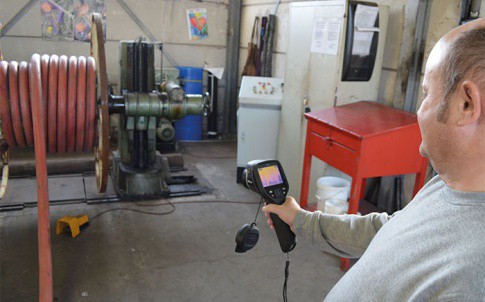
Heavy industries such as mining, shipbuilding and materials handling rely on heavy, rugged, industrial cables to ensure continuous power supply or communication. This dependency means the consequences of a cable break are costly both in terms of lost productivity and downtime. So, for the German cable repair specialist Becker and Hüser, its focus is to get its customers back in business in the shortest amount of time and FLIR thermal imaging is playing a vital role in helping to pinpoint the exact location of the problem.
“Repairing a cable is often the most time efficient option if a replacement is not held in stock, as waiting for the supply of a new cable can sometimes take months,” explained Managing Director, Andreas Becker. “We can repair a cable in a matter of days and sometimes even hours and that can really make a difference if, for example, the fault is preventing a ship leaving harbour.”
Cable repair requires a lot of manual labour. The process involves the connection of an enormous tangle of fibres which is both a meticulous and time-consuming task. There is also no instant method of locating a fault inside a cable but Becker and Hüser have invested in a range of technologies to make this process as quick and efficient as possible and that now includes FLIR thermal imaging.
Commonly, the company uses a surge voltage generator for locating and pin-pointing high and low resistance faults in power cables. The stored energy of the high voltage capacitors is fed at intervals into the faulty cable. This causes noise at the fault position which can be detected either by sight - a high voltage surge can generate sparks, by feeling with a rubber glove, or even by hearing.
This method, however, is not fool proof. So when, at a trade show, Andreas Becker saw how quickly and accurately thermal imaging can display voltage changes as heat differences he decided to invest in a FLIR camera to complement traditional methods. The model he chose is a FLIR E40bx troubleshooting camera because it is easy to use, straight out of the box. It provides a temperature measurement range of -20°C to +120°C with an accuracy of ±2%.
Other features that proved decisive in the purchase was MSX thermal image enhancement that allows numbers, labels and other key visual details to be seen in an all-in-one thermal picture. Also important to Becker and Hüser is the camera’s ability to be linked via Wi-Fi to a mobile device or smart phone. This allows engineers to transfer images, add further measurement spots, re-adjust level and span, change palettes, create reports and email findings to decision makers or customers.
“When all our traditional methods of fault detection fail, we know that we can still use our FLIR camera to locate the problem” Andreas Becker continued. “It is particularly effective on faults at the end of the cable, right at the point of connection, that are difficult to detect by other means. The camera can see the heat difference without any problem. And it’s also ideal for inspecting the entire length of a cable as it is wound from reel to reel.”
He concluded “It is an enormous advantage to be able to show the location and nature of the fault and the FLIR camera allows us to do just that. It gives our customers confidence that we are on top of the problem.”










Simulations show Optimal Design for Bladeless Wind Turbines
"an 80cm mast" Really? I'm short but that's only half my height! Do they mean 800cm?